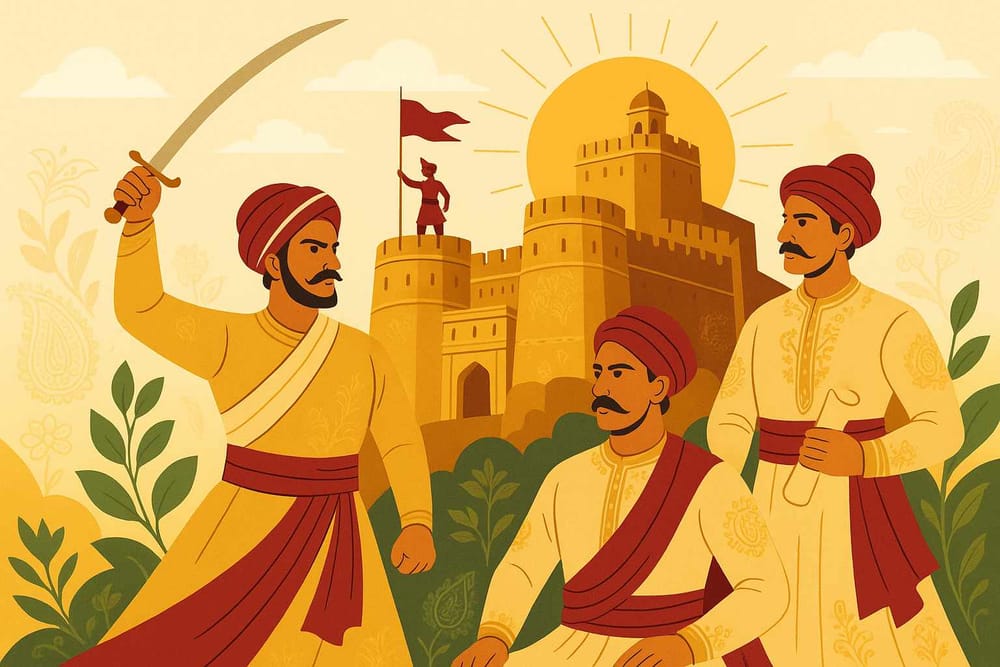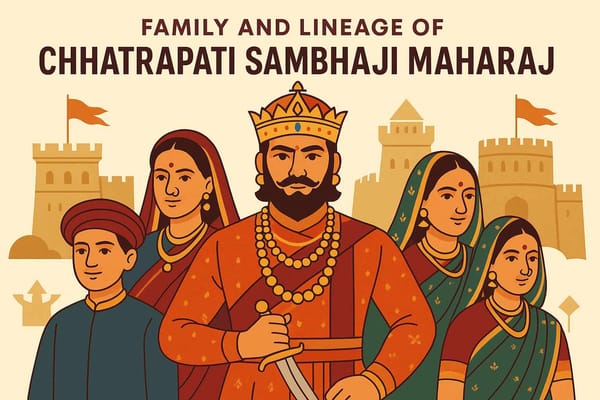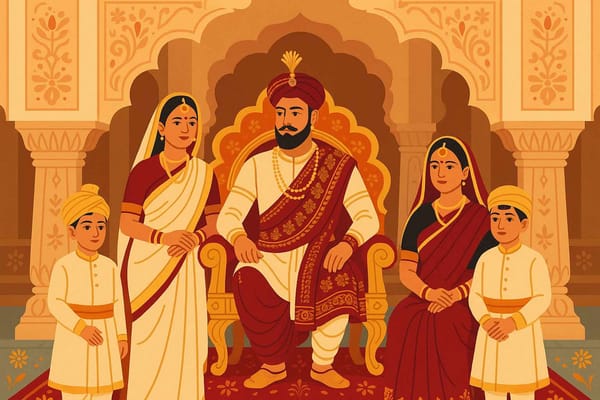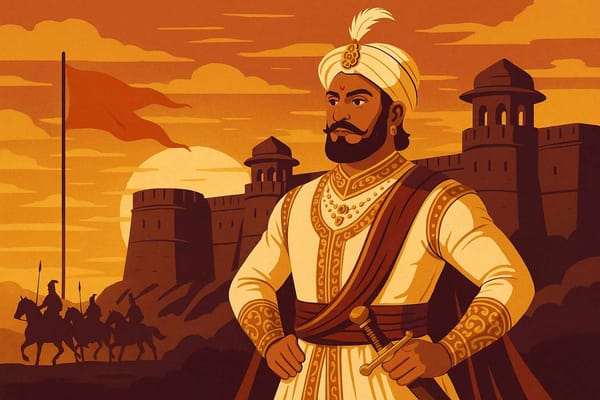
The Maratha Empire: Resilience and Transformation After Shivaji and Sambhaji - A 2025 Perspective
In the heart of every Indian, especially those from Maharashtra, the chant of "Jai Bhavani, Jai Shivaji!" evokes a deep sense of pride. We often think of the Maratha Empire through the inspiring lives of Chhatrapati Shivaji Maharaj and his valiant son, Sambhaji Maharaj. But have you ever wondered what happened to the dream of 'Hindavi Swarajya' after them? The story doesn't end there; in fact, it transforms into a saga of incredible resilience, strategic brilliance, and expansion that truly shaped the destiny of Bharat.
This isn't just a history lesson. It's the story of a people who, after losing their king, refused to lose their spirit. It’s a journey that shows us how a legacy is not just inherited but is actively fought for and reimagined by every generation.
A Kingdom in Crisis: The Fight for Survival After Sambhaji Maharaj
The year 1689 was a dark time. The brutal execution of Sambhaji Maharaj by Aurangzeb was meant to shatter the Maratha spirit. It created a dangerous vacuum, a moment where the empire could have easily crumbled. But the Maratha soil is different. It nurtures fighters. Sambhaji's younger brother, Rajaram Maharaj, immediately took up the mantle.
Facing the full might of the Mughal army, Rajaram knew that a direct confrontation was suicide. He embraced his elder brother's legacy of guerrilla warfare, the 'ganimi kava', turning the Sahyadri mountains into a fortress of resistance. The empire’s resilience during this period was not just due to one man, but a collective effort. Legendary commanders like Santaji Ghorpade and Dhanaji Jadhav became nightmares for the Mughal forces, proving that the Maratha spirit was far from broken. Rajaram's strategic retreat to the distant fort of Gingee in Tamil Nadu was a masterstroke, stretching the Mughal supply lines and keeping the flame of Swarajya alive from afar.
The Reign of an Iron Queen: Maharani Tarabai's Leadership
When Rajaram Maharaj passed away in 1700, the Mughals believed their victory was near. They underestimated the power of a Maratha queen. Maharani Tarabai, Rajaram's widow, emerged as a force of nature. She took control as the regent for her young son, Shivaji II, and what followed was a period of fierce resistance that left even Aurangzeb stunned.
She wasn't a leader who sat in her palace. Tarabai was on the battlefield, rallying her troops, planning strategies, and managing the empire with incredible skill. She proved that leadership knows no gender. Her determination ensured that the Maratha territories were not just defended but expanded, turning the tide against the Mughals. This era forever changed the perception of women in governance and stands as a powerful testament to their contribution in our history.
A New Dawn: The Rise of the Peshwas and Administrative Genius
After Aurangzeb's death, a new chapter began with the release of Shahu Maharaj, Sambhaji's son, from Mughal captivity. His return led to some internal conflict but ultimately resulted in a brilliant administrative evolution: the rise of the Peshwas (Prime Ministers). This was a crucial transformation. As the Chhatrapati became the symbolic head, the Peshwas became the de facto rulers, managing the day-to-day affairs of the vast empire.
Balaji Vishwanath, the first powerful Peshwa, was a master diplomat. He healed the internal rifts and stabilized the administration. But it was his son, the legendary Bajirao I, who transformed the Maratha Empire into an unstoppable force. With his philosophy of "Attock par zenda," he envisioned the saffron flag flying across the entire subcontinent. His military campaigns were lightning-fast and devastatingly effective, expanding Maratha influence from the Deccan deep into northern India, forever weakening Mughal dominance.
The Saffron Tide: Forging a Grand Maratha Confederacy
Under the Peshwas, the Maratha Empire evolved into a unique political structure known as the Maratha Confederacy. It was a brilliant system that allowed for rapid expansion. Power was distributed among mighty Maratha chieftains who carved out their own semi-independent states, all while owing allegiance to the Chhatrapati and the Peshwa in Pune.
- The Scindias of Gwalior: They established a powerful kingdom in the north, playing a crucial role in the politics of Delhi and shaping the destiny of the falling Mughal throne.
- The Holkars of Indore: Known for their military prowess and administrative skills, they became a dominant power in Malwa and Central India, contributing significantly to the confederacy's strength.
- The Gaekwads of Baroda: They established their influence over Gujarat, becoming a major economic and military force in the western part of India.
- The Bhonsles of Nagpur: Ruling over a large territory in Central and Eastern India, they were instrumental in expanding Maratha influence towards Bengal. Much like other regional kingdoms, these royal traditions helped shape local celebrations, creating unique cultural identities within the larger Maratha fold.
This decentralized structure allowed for localized governance and quick military responses, enabling the Marathas to manage a vast territory that stretched across the Indian subcontinent.
Challenges and the Setting Sun
No empire lasts forever, and the Marathas faced their share of monumental challenges. The devastating loss at the Third Battle of Panipat in 1761 against Ahmad Shah Abdali was a massive blow, not just militarily but psychologically. It checked their northward expansion and exposed the cracks in their unity.
Internal conflicts and leadership disputes began to weaken the confederacy from within. The very structure that allowed for expansion also led to rivalries among the chieftains. This disunity was cleverly exploited by a new, rising power—the British East India Company. Through a series of three Anglo-Maratha Wars, the British, with their superior military technology and cunning diplomacy, eventually dismantled the confederacy, and in 1818, the last Peshwa was defeated, marking the end of the Maratha Empire.
Reflecting on the Maratha Legacy in 2025
So, what does the Maratha Empire mean to us in 2025? It is more than just a chapter in our history books. It is a powerful symbol of resilience, a story of how a people can rise from the ashes and redefine their destiny. The Marathas were the last great indigenous power to hold sway over a significant part of India before the colonial era. Their administrative systems, military tactics, and, most importantly, their indomitable spirit left a lasting mark on India's political and cultural landscape.
Their story reminds us that leadership can come from anyone, be it a king, a queen, or a prime minister. It teaches us about the strength of unity and the dangers of internal division. The legacy of the Maratha Empire inspires us to honor our traditions while adapting to the challenges of the modern world.
At Bhaktilipi, we believe in keeping these powerful stories alive. Our traditions and our history are what give us our roots and our strength. If you wish to dive deeper into the timeless devotional literature and sacred stories that have inspired heroes for centuries, we invite you to explore our platform. Discover the spiritual heart of our culture with us.
Stay connected for more such inspiring stories from our shared past:
- Facebook: Bhaktilipi Official
- Instagram: @bhakti_lipi
- YouTube: Bhaktilipi Channel
Subscribe to our newsletter to continue this journey of rediscovering the soul of India, one story at a time.
A passionate group of people dedicated to preserving India's knowledge of Dharma, Karma, and Bhakti for ourselves and the world 🙏.
Comments
Related in

The Pillars of the Maratha Empire: Chhatrapati Sambhaji Maharaj's Family Explained
Whenever we hear the word ‘Swarajya,’ our hearts fill with a deep sense of pride. We imagine the glorious saffron flag, the ‘Bhagwa Dhwaj,’ flying high over the forts of the Sahyadris. We remember the unparalleled valour of Chhatrapati Shivaji Maharaj. But behind every great leader and every grand empire,

The Royal Lineage- Chhatrapati Sambhaji Maharaj's Family Explained
जब हम किसी विशाल, मजबूत पेड़ को देखते हैं, तो हमारा ध्यान अक्सर उसकी शाखाओं और पत्तों पर जाता है। लेकिन उस पेड़ की असली ताकत तो उसकी जड़ों में छिपी

The Story of 'Chhava': Cinema Depicts Sambhaji Maharaj
In the grand tapestry of Bharat's history, some threads shine with a fire that time cannot dim. The story of Chhatrapati Sambhaji Maharaj, the valiant son of the great Chhatrapati Shivaji Maharaj, is one such thread. His name itself evokes a feeling of immense pride and deep sorrow.
